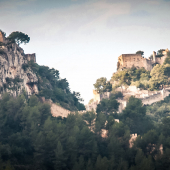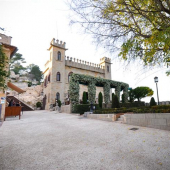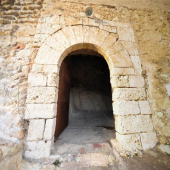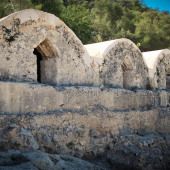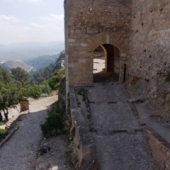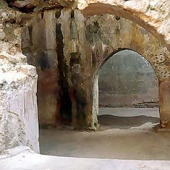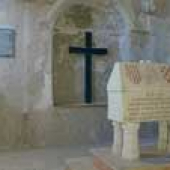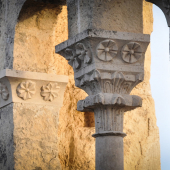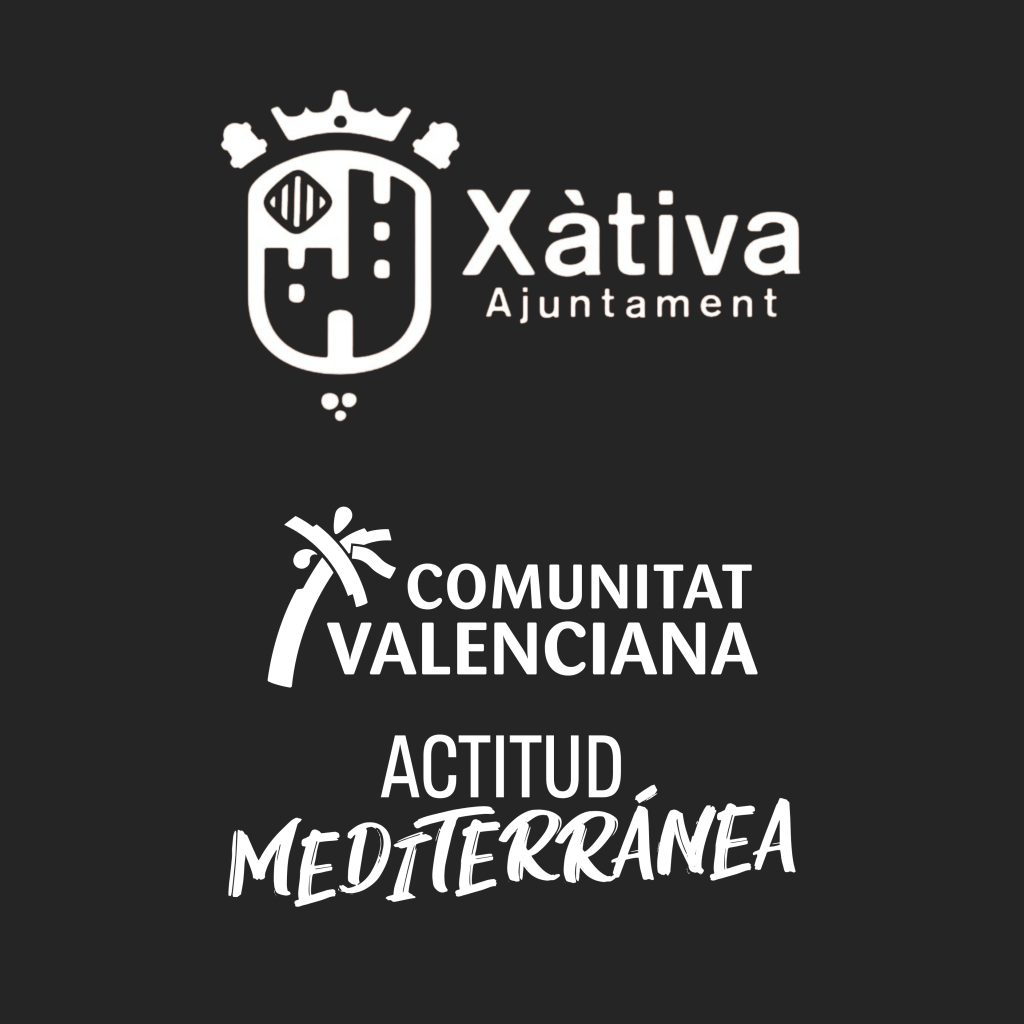EL CASTELL
“Qui en Xàtiva volrà entrar
sobre nós haurà de pasar”
(Whomsoever in Xàtiva wishes to enter
Will have to vanquish its defenders)
– Chronicle of Jaume I –
sobre nós haurà de pasar”
Will have to vanquish its defenders)
EL CASTELL (the castle)
A watchtower with a wealth of history
Thanks to its strategic location perched high above Xàtiva on the sierra del Castell hill, this twin fortress has been the scene and spectator of a host of battles. Gradually expanded and fortified by the successive cultures that have inhabited these lands, the castle is divided into the Castell Menor, which sits atop Iberian and Roman remains, and the Castell Major. It already featured in Hannibal’s campaigns and the Al-Ándalus period, and subsequently assumed importance for the Kingdom of Valencia in the wars against Castile, the Revolt of the Brotherhoods and the War of the Spanish Succession. It was also used to as a prison for illustrious captives.
The castle forms the highest point of the defensive walls that once encircled early mediaeval Xàtiva. Despite its Iberian and Roman roots, most of castle walls and towers preserved today are of Islamic or Gothic origin. Its imposing architecture renders the castle one of the city’s finest gems, and it has been declared a Cultural Heritage Site. No visit to Xàtiva is complete without a trip around this fortress, with stunning views over the city and its surroundings.
Thanks to its strategic location perched high above Xàtiva on the sierra del Castell hill, this twin fortress has been the scene and spectator of a host of battles. Gradually expanded and fortified by the successive cultures that have inhabited these lands, the castle is divided into the Castell Menor, which sits atop Iberian and Roman remains, and the Castell Major. It already featured in Hannibal’s campaigns and the Al-Ándalus period, and subsequently assumed importance for the Kingdom of Valencia in the wars against Castile, the Revolt of the Brotherhoods and the War of the Spanish Succession. It was also used to as a prison for illustrious captives.
The castle forms the highest point of the defensive walls that once encircled early mediaeval Xàtiva. Despite its Iberian and Roman roots, most of castle walls and towers preserved today are of Islamic or Gothic origin. Its imposing architecture renders the castle one of the city’s finest gems, and it has been declared a Cultural Heritage Site. No visit to Xàtiva is complete without a trip around this fortress, with stunning views over the city and its surroundings.
PORTA FERRISSA GATE
The Porta Ferrissa (iron gate) is the main entrance to the castle. Despite the alterations carried out in the mid-20th century, it is still located in approximately the same place as the original. Formerly, it was preceded by another gate, the Porta Forana, but this was blown up in 1813 by the retreating French army at the end of the Peninsular War. The frieze depicts the city’s coat of arms between two royal emblems.
PLAZA DE ARMAS SQUARE
This is the castle’s central courtyard and gives on to the Castell Menor to the left, of Iberian origin, and the Castell Major to the right, of Islamic origin with constructions from the mediaeval Christian period. It also houses a recent neo-Gothic residence, of 20th century construction.
PORTA FERRISSA GATE
The Porta Ferrissa (iron gate) is the main entrance to the castle. Despite the alterations carried out in the mid-20th century, it is still located in approximately the same place as the original. Formerly, it was preceded by another gate, the Porta Forana, but this was blown up in 1813 by the retreating French army at the end of the Peninsular War. The frieze depicts the city’s coat of arms between two royal emblems.
PLAZA DE ARMAS SQUARE
This is the castle’s central courtyard and gives on to the Castell Menor to the left, of Iberian origin, and the Castell Major to the right, of Islamic origin with constructions from the mediaeval Christian period. It also houses a recent neo-Gothic residence, of 20th century construction.
El Castell Menor
This is the oldest part of the castle, dating back to Iberian and Roman times, and sits atop the sheer slopes of the Penya Roja. Gazing towards the east, it provides dramatic views over the valley of Bixquert.
A stroll around the Castell Menor evokes legends about the Iberian Princess Himilce, Hannibal’s wife, and the war Hannibal unleashed against Rome. It is said that Himilce bore the Carthaginian general’s son here, in 218 BC. Due to its strategic position, the fortress commands the Via Augusta Roman road and so was witness to Hannibal’s campaigns and those of the Roman generals Scipio and Sertorius.
HANNIBAL’S GATE
According to the Roman poet Silius Italicus, it was in Xàtiva that Hannibal made his preparations for the siege of the Roman city of Saguntum. Legend has it that the Carthaginian general entered the castle through this gate, as did his enemy, Publius Cornelius Scipio, years later. The present gate is more recent, dating to the 15th century.
THE WALLS AND THE SQUARE TOWER
The square tower that rises in the corner of the wall served as a watchtower. The base is of Roman masonry, a vestige of the original fortress.
THE SECOND GATE
The second gate into the Castell Menor is located in another Gothic tower. It was originally built during the Islamic period, in the 10th century, as evidenced by its defensive L-shaped layout, and was later restored in the 15th century.
HANNIBAL’S GATE
According to the Roman poet Silius Italicus, it was in Xàtiva that Hannibal made his preparations for the siege of the Roman city of Saguntum. Legend has it that the Carthaginian general entered the castle through this gate, as did his enemy, Publius Cornelius Scipio, years later. The present gate is more recent, dating to the 15th century.
THE WALLS AND THE SQUARE TOWER
The square tower that rises in the corner of the wall served as a watchtower. The base is of Roman masonry, a vestige of the original fortress.
THE SECOND GATE
The second gate into the Castell Menor is located in another Gothic tower. It was originally built during the Islamic period, in the 10th century, as evidenced by its defensive L-shaped layout, and was later restored in the 15th century.
HIMILCE’S BALCONY
HIMILCE’S BALCONY
El Castell Major
Perched on the crest of the sierra de Vernissa hill, to the right of the Plaza de Armas square, rises the Castell Major. Of later construction, built in mediaeval times, this is the most extensive and best preserved part of the castle. Its imposing ramparts look towards the west. After the Christian conquest led by Jaume I, this became the main defensive stronghold along the road between Castile and the capital of the Kingdom of Valencia.
The Castell Major encloses spaces and rooms that conjure up daily life in the fortress: entrance gates, watchtowers, water tanks for the guard, a chapel and the cells where some of its famous prisoners counted their days.
PUERTA DEL SOCORRO GATE
Located at the back of the Castell, this gate opens on to the valley of Bixquert. Its name evokes the Revolt of the Brotherhoods in 16th century Valencia and the help requested by Lluís Crespi of Valldaura, lord of Sumacàrcer and l’ Alcúdia, before dying at the hands of the agermanats, members of the working classes who staged the rebellion.
THE FOUR CISTERNS
Water was vital for life in the castle, and the supply came from rain water which was collected and stored in cisterns. In addition to others, these four, originally of Roman construction but restored in mediaeval times, have been preserved in superb condition. Only recently opened to the public, this area was once used to house livestock and animals.
PUERTA DEL SOCORRO GATE
Located at the back of the Castell, this gate opens on to the valley of Bixquert. Its name evokes the Revolt of the Brotherhoods in 16th century Valencia and the help requested by Lluís Crespi of Valldaura, lord of Sumacàrcer and l’ Alcúdia, before dying at the hands of the agermanats, members of the working classes who staged the rebellion.
THE FOUR CISTERNS
Water was vital for life in the castle, and the supply came from rain water which was collected and stored in cisterns. In addition to others, these four, originally of Roman construction but restored in mediaeval times, have been preserved in superb condition. Only recently opened to the public, this area was once used to house livestock and animals.
PUERTA DE SANTA MARÍA GATE
The third of the Castell Major’s gates, the Puerta de Santa María was of Islamic origin. The part that remains today was rebuilt in the 15th century.
COUNT D’URGELL’s CELL
The fortress was also used as a State prison by the ancient Crown of Aragon, and several noble prisoners passed through its dungeons. The most renowned of these was Jaume d’Urgell, who led an unsuccessful rebellion after being rejected as a candidate to the Crown of Aragon in the 1412 Compromise of Caspe. Legend has it that after long imprisonment in this gloomy cell, he was struck blind on leaving it in broad daylight, and died.
CAPILLA DE LA REINA MARÍA CHAPEL
This delicate and exquisite Gothic chapel, commissioned in the 15th century by Queen María of Castile, has recently been restored. It houses the remains of Jaume d’Urgell, who died a prisoner in 1433. It is a small, rectangular church, with masonry walls.
PUERTA DE SANTA MARÍA GATE
The third of the Castell Major’s gates, the Puerta de Santa María was of Islamic origin. The part that remains today was rebuilt in the 15th century.
COUNT D’URGELL’s CELL
The fortress was also used as a State prison by the ancient Crown of Aragon, and several noble prisoners passed through its dungeons. The most renowned of these was Jaume d’Urgell, who led an unsuccessful rebellion after being rejected as a candidate to the Crown of Aragon in the 1412 Compromise of Caspe. Legend has it that after long imprisonment in this gloomy cell, he was struck blind on leaving it in broad daylight, and died.
CAPILLA DE LA REINA MARÍA CHAPEL
This delicate and exquisite Gothic chapel, commissioned in the 15th century by Queen María of Castile, has recently been restored. It houses the remains of Jaume d’Urgell, who died a prisoner in 1433. It is a small, rectangular church, with masonry walls.
GARDENS OF IBN HAZM
GARDENS OF IBN HAZM
Information
XÀTIVA CASTLE
Carretera del Castell
Telephone 962 283 787
Opening hours from 1st September:
Tuesday to Sunday, from 10am to 8pm.
PET FRIENDLY
Ticket Online
Here your tickets
Information
XÀTIVA CASTLE
Carretera del Castell
Telephone 962 283 787
Opening hours from 1st September:
Tuesday to Sunday, from 10am to 8pm.
PET FRIENDLY
Ticket Online
Here your tickets
AUDIO GUIDES
